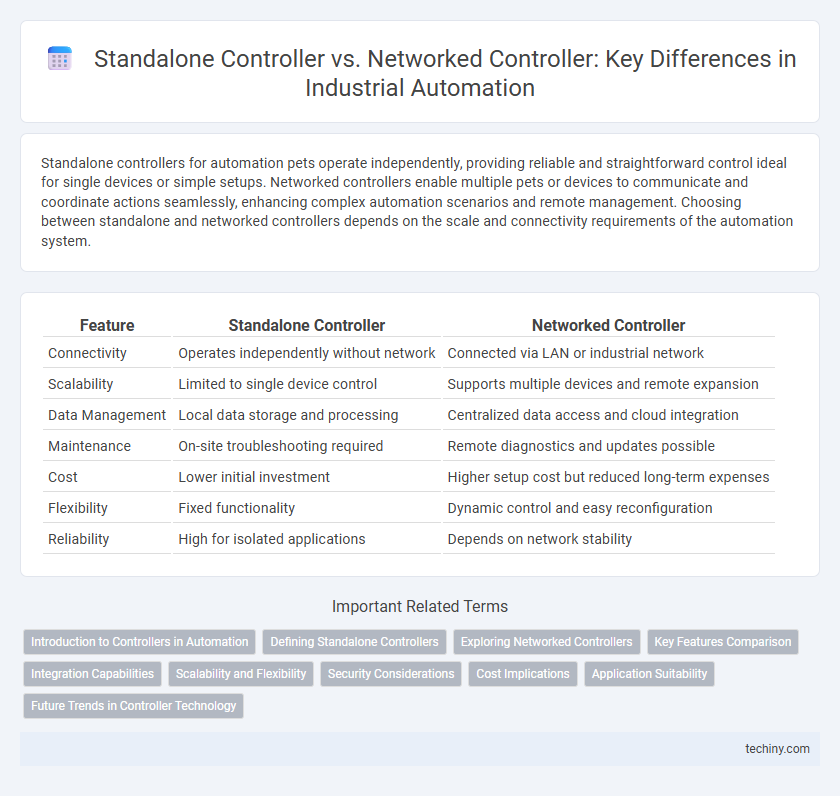Standalone controllers for automation pets operate independently, providing reliable and straightforward control ideal for single devices or simple setups. Networked controllers enable multiple pets or devices to communicate and coordinate actions seamlessly, enhancing complex automation scenarios and remote management. Choosing between standalone and networked controllers depends on the scale and connectivity requirements of the automation system.
Table of Comparison
| Feature | Standalone Controller | Networked Controller |
|---|---|---|
| Connectivity | Operates independently without network | Connected via LAN or industrial network |
| Scalability | Limited to single device control | Supports multiple devices and remote expansion |
| Data Management | Local data storage and processing | Centralized data access and cloud integration |
| Maintenance | On-site troubleshooting required | Remote diagnostics and updates possible |
| Cost | Lower initial investment | Higher setup cost but reduced long-term expenses |
| Flexibility | Fixed functionality | Dynamic control and easy reconfiguration |
| Reliability | High for isolated applications | Depends on network stability |
Introduction to Controllers in Automation
Standalone controllers operate independently, managing specific tasks within automation systems without relying on external communication networks. Networked controllers, in contrast, integrate multiple devices and sensors through communication protocols like Ethernet/IP or Modbus, enabling centralized monitoring and control. Selecting between standalone and networked controllers depends on system complexity, scalability requirements, and the need for real-time data exchange across automation components.
Defining Standalone Controllers
Standalone controllers are dedicated devices designed to manage specific automation tasks independently without relying on external networks or controllers. These controllers feature built-in processing capabilities, memory, and input/output interfaces that enable direct control of machinery or processes within a localized environment. Ideal for applications requiring high reliability and simplicity, standalone controllers minimize communication delays and reduce complexity in automation systems.
Exploring Networked Controllers
Networked controllers enable seamless communication between multiple devices, enhancing data exchange and real-time monitoring in automation systems. These controllers support protocols like Ethernet/IP and Modbus TCP, allowing integration with SCADA and MES for improved process control. Networked controllers reduce wiring complexity and enable scalable architectures, leading to increased system flexibility and quicker troubleshooting.
Key Features Comparison
Standalone controllers provide independent operation with localized control, ideal for simple automation tasks requiring minimal integration, featuring dedicated input/output (I/O) points and direct user interface access. Networked controllers enable distributed control across multiple devices through communication protocols like Ethernet/IP or Modbus, supporting scalable and flexible automation systems with centralized monitoring and real-time data exchange. Key features comparison highlights that standalone controllers offer simplicity and reliability, while networked controllers excel in connectivity, interoperability, and advanced diagnostics.
Integration Capabilities
Standalone controllers operate independently with limited integration options, suitable for isolated automation tasks. Networked controllers offer advanced integration capabilities, enabling seamless communication with other devices, systems, and centralized management platforms through protocols like Ethernet/IP, Modbus, and Profinet. This connectivity enhances scalability, real-time data exchange, and coordinated control in complex industrial environments.
Scalability and Flexibility
Standalone controllers offer limited scalability due to their fixed input/output capacity, making them ideal for small-scale automation tasks with minimal expansion needs. Networked controllers enhance scalability by allowing integration of multiple devices across a distributed system, supporting complex operations and future growth. Flexibility is significantly higher in networked controllers, as they enable centralized monitoring and reprogramming, adapting quickly to changing process requirements.
Security Considerations
Standalone controllers offer enhanced security by operating independently, reducing exposure to network-based cyber threats often associated with networked controllers. Networked controllers, while enabling centralized monitoring and control, require robust cybersecurity measures such as firewalls, encryption protocols, and access controls to mitigate vulnerabilities inherent in network connectivity. Proper segmentation and regular security audits are critical to maintaining the integrity and resilience of networked control systems against potential attacks.
Cost Implications
Standalone controllers typically incur higher initial hardware costs due to dedicated processing units but reduce ongoing network maintenance expenses. Networked controllers, while often less expensive per unit, require investment in robust communication infrastructure and integration, driving up total cost of ownership. Evaluating cost implications depends on project scale, with standalone solutions favorable for small systems and networked controllers optimized for large-scale automation requiring centralized management.
Application Suitability
Standalone controllers excel in applications requiring simple, localized control with minimal external communication, ideal for isolated machinery or processes. Networked controllers are suited for complex automation systems demanding real-time data exchange, centralized monitoring, and coordination across multiple devices or production lines. Selecting between standalone and networked controllers depends on scalability, integration needs, and the complexity of the application environment.
Future Trends in Controller Technology
Standalone controllers offer simplicity and reliability for isolated automation tasks, while networked controllers enable advanced connectivity and real-time data exchange across industrial IoT ecosystems. Emerging trends emphasize the integration of AI-driven analytics and edge computing within networked controllers to enhance predictive maintenance and operational efficiency. Future controller technology will prioritize cybersecurity, interoperability standards, and scalable architectures to support increasingly complex automation environments.
Standalone Controller vs Networked Controller Infographic

 techiny.com
techiny.com